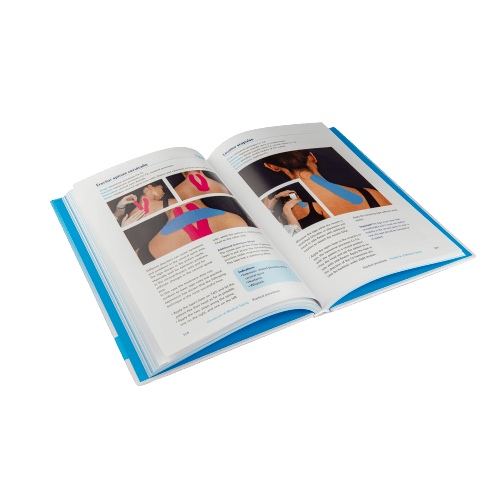Understanding Neck Pain
Neck pain affects a large percentage of the population at some point in their lives. The neck is made up of seven cervical vertebrae, cushioned by intervertebral discs that absorb shock. The skull rests on the first cervical vertebra, and the second vertebra allows the head to turn. Muscles and ligaments in the neck provide stability and enable movement. When these structures are strained or injured, it can lead to significant pain and discomfort.
Causes of Neck Pain
Neck pain can have various causes and symptoms, which require different treatments. These complaints can be acute or chronic and are classified as specific or non-specific. Specific complaints are those where tissue damage is visible on imaging tests like X-rays or MRIs, such as wear and tear, herniated discs, or osteoporosis. Non-specific complaints lack a clear identifiable cause but often involve muscle knots and tissue tension. Kinesiology taping can be a beneficial solution for many types of neck pain, helping to relieve symptoms and improve quality of life.
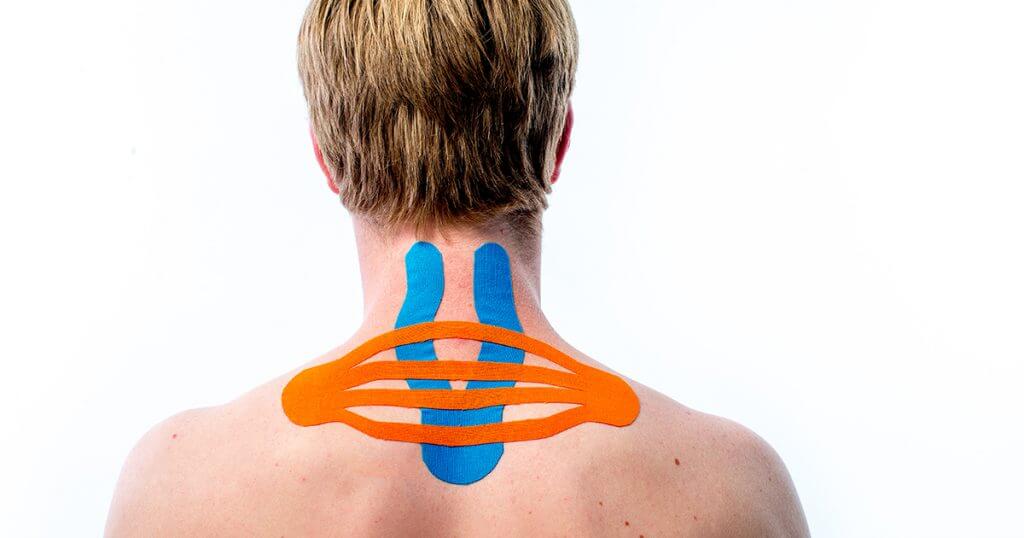
Symptoms of neck pain
- Stiff feeling in the neck
- Tingling or loss of strength in the arms
- Dizziness
- Stabbing pain
- Radiating pain to the head, shoulders, back or arms and hands
- Restriction of movement with turning and bending of the neck
Headaches
Few people can say they’ve never experienced a headache. While headaches are often temporary and linked to common issues like the flu, colds, sinusitis, poor vision, poor ventilation, sleep problems, or hormonal changes, they can still significantly impact your daily life. There are various types of headaches, including tension headaches, migraines, facial pain, and cluster headaches.
Causes of Headaches
Besides the more common causes mentioned above, headaches can also stem from bad posture, tension, or stress. In our digital age, improper head positioning relative to the neck is a frequent cause of neck muscle strain, leading to headaches. Trigger points in the muscles can also contribute to these uncomfortable symptoms. Understanding these causes is the first step toward effective relief, and using techniques like kinesiology taping can help manage and reduce headache pain.
Symptoms of headaches
- Slight to moderate, dull pressing pain in the head
- Stiff feeling in the neck
- Tingling or loss of strength in the arms
- Dizziness and slight nausea
- Stabbing pain
- Radiating pain to the head, shoulders, back or arms and hands
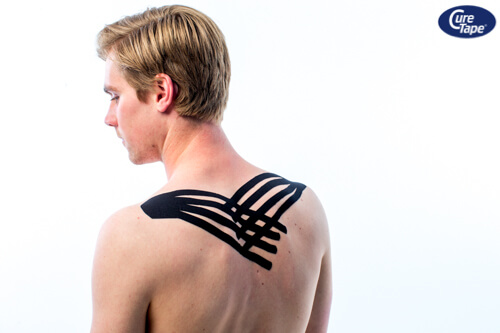
What to do about headaches and neck pain?
There are various treatments available for neck pain and headaches using Kinesiology taping. The techniques described below can address different symptoms. It’s crucial to obtain an accurate diagnosis to create an effective treatment plan. For instance, a headache might originate from the lower back and not necessarily be a direct result of neck pain.
Get started with these items to tape neck pain
-
CureTape® Classic Kinesiology Tape
Bestseller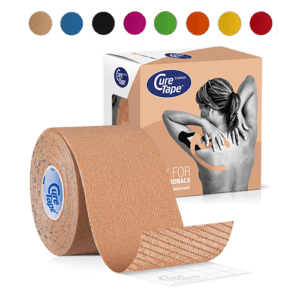 $19.95
In stockSelect options This product has multiple variants. The options may be chosen on the product page
$19.95
In stockSelect options This product has multiple variants. The options may be chosen on the product page -
CureTape® Sports Extra Sticky Kinesiology Tape
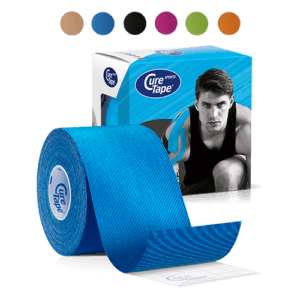 $21.95
In stockSelect options This product has multiple variants. The options may be chosen on the product page
$21.95
In stockSelect options This product has multiple variants. The options may be chosen on the product page -
CureTape® Art Printed Kinesiology Tape
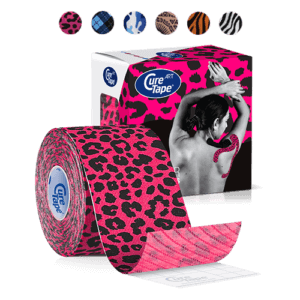 $21.95
In stockSelect options This product has multiple variants. The options may be chosen on the product page
$21.95
In stockSelect options This product has multiple variants. The options may be chosen on the product page -
Standard scissors
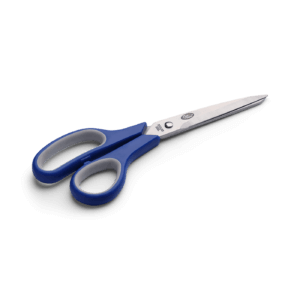 $14.95
In stockAdd to cart
$14.95
In stockAdd to cart
How to tape in case of increased tissue tension or tension headaches

Here’s how to apply the tape:
- Place the base of the first strip of tape on the acromion (the bony point of your shoulder) without stretching it.
- Tilt your head to the opposite side and run the tape towards the base of your skull.
- For the second strip of tape, apply it with your head in a neutral position at the insertion point of the levator scapulae muscle.
- Tilt your head to the side and stretch the tape slightly as you run it towards the side of your neck.
These techniques can help relieve tension in your neck muscles and reduce headache symptoms.
Lymphatic tape for extension problems or osteoarthritis
- Cut a Y tape. Place the base of the tape at thoracic vertebrae 4/5 and let the patient perform a maximal flexion with the head
- Run the two strips of tape at heterolateral head rotation to the right and left of the spine
- Then cut an I tape. Fold it in half and cut it twice from the fold so that there are 4 strips within the I tape
- Place the tape with maximum stretch over the cervical-thoracic transition. Then spread the strips over a wider area
Instructions for self taping (non-professionals)
- Cut a Y-shaped piece of tape. Place the base of the tape at the middle of your upper back (around thoracic vertebrae 4/5). Bend your head forward as much as you can.
- Place the two arms of the tape along the sides of your spine, following the movement of your head to the right and left.
- Next, cut an I-shaped piece of tape. Fold it in half and cut it into four strips from the folded end.
- Stretch the tape as you apply it over the area where your neck meets your upper back. Then, spread the strips out to cover a wider area.

Lymphatic tape for whiplash, CWK complaints or tension headaches

- Cut a lymph tape from two strips of tape.
- Apply the strips of tape without stretching and allow the ends to cross.
The lymphatic strips ensure a rapid drainage of fluids and waste products, as well as better circulation in the affected area, and the tissue relaxes. This way of taping can be used for whiplash complaints or other neck and neck complaints where there is an increased tension of the tissue.

Christina’s advice when taping your neck
When taping your neck, it’s crucial to choose a tape that provides strong adhesion and support. That’s why I recommend CureTape kinesiology tape. For regular use, CureTape Classic or Art is ideal. However, if you’re engaging in extreme sports or swimming, opt for the extra sticky CureTape Sports variant!
Learn how to tape
- The Ultimate Taping Guide: Focuses on self-taping for the 30 most common injuries where taping provides support.
- Kinesiology Taping Method Manual: Designed for (para medical) professionals, covering basic taping techniques and various pathologies.
- Decompressive Taping Techniques Manual: Specifically focuses on lymphatic taping methods for decompression.
What are you waiting for? Order a copy today!
THYSOL is the manufacturer of the kinesiology tape brand CureTape. As CureTape, we have been training and supplying professionals for 25 years. And consumers now know how to find us too! By manufacturing all our tapes in our own factory, we can guarantee the best quality!
Please note that the indicated tape applications and information on our website about the possibilities with kinesiology tape have not yet been scientifically proven. The statements and examples mentioned are based on long-term experiences of patients and trained therapists.
Contraindications not to tape: pregnancy, open wounds, broken bones, unexplained complaints, allergies and skin diseases, use of medication such as blood thinners, thrombosis and fever. Always apply tape in consultation with a specialist.

